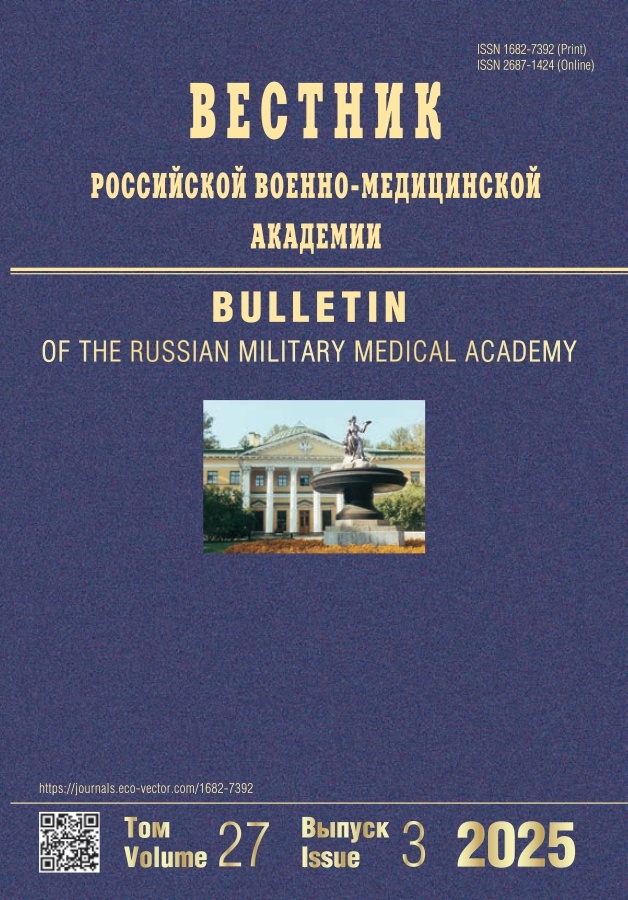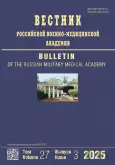Patterns of periodization of adaptive and compensatory changes in body composition in students of military educational schools
- Authors: Semenov A.A.1
-
Affiliations:
- Kirov Military Medical Academy
- Issue: Vol 27, No 3 (2025)
- Pages: 361-366
- Section: Original Study Article
- URL: https://bakhtiniada.ru/1682-7392/article/view/319567
- DOI: https://doi.org/10.17816/brmma645335
- EDN: https://elibrary.ru/BXYUCN
- ID: 319567
Cite item
Abstract
BACKGROUND: The fundamental, basic nature and rich scientific tools developed as part of the concept of biological rhythms can be extrapolated from the study of body composition to interpret its variability.
AIM: The work aimed to analyze published evidence and research findings and identify patterns of periodization of changes in body composition during training in military educational schools.
METHODS: The work was based on a supporting review and a research conducted by Gaivoronsky et al. at a higher military educational school. A linked sample of 387 male and 27 female students aged 17–23 years (first to sixth years) who had completed their studies between 2017 and 2023 was evaluated. Body composition was measured using the Tanita MC-780 MA body composition analyzer.
RESULTS: Two rhythms responsible for the patterns of adaptive and compensatory changes in body composition were identified. The “relative rest” rhythm includes fat component, total fat mass, visceral fat, and metabolic age. The “physical activity and cognitive load” rhythm comprises muscle mass, fat-free mass, and sarcopenia index. This rhythm is characterized by acrophase that occurs during the cycle periods associated with the highest functional stress levels, regardless of the chronological length of the biological cycle. This is the time of physical and mental stress in the day schedule, luteal phase of the menstrual cycle (in females), summer season, and first 2 years of study in the military educational school. The “relative rest” rhythm is characterized by acrophase that occurs during the cycle periods associated with minimal functional stress. These periods include the time of awakening in the day schedule, menstruation (in females), the winter season, and year 4–5 of study in the military educational school.
CONCLUSION: Subsequent expansion of the scientific discourse will prioritize the development of indices derived from the periodization of changes in body composition to address prediction, monitoring, and screening.
Full Text
##article.viewOnOriginalSite##About the authors
Alexey A. Semenov
Kirov Military Medical Academy
Author for correspondence.
Email: vmeda-nio@mil.ru
ORCID iD: 0000-0002-1977-7536
SPIN-code: 1147-3072
MD, Cand. Sci. (Medicine), Assistant Professor
Russian Federation, 6Zh Akademika Lebedeva st., Saint Petersburg, 194044References
- Rostovtseva MV. Methodological Approaches to Studying Personal Social Adaptation. Krasnoyarsk: Siberian Federal University; 2021. (In Russ.) ISBN: 978-5-7638-4417-7 EDN: LMSSRQ
- Krishtop V, Nikonorova V, Gutsalova A, et al. Systematic comparison of main animal models of cerebral hypoperfusion. Tissues and Cells. 2022;75:101715. doi: 10.1016/j.tice.2021.101715
- Gaivoronsky IV, Semenov AA, Krishtop VV. Dynamics of body composition parameters in females during their training at a Military Medical University. Journal of Anatomy and Histopathology. 2024;13(2):9–15. doi: 10.18499/2225-7357-2024-13-2-9-15 EDN: WPWYNA
- Gaivoronsky IV, Semenov AA, Krishtop VV, et al. Sexual characteristics of physical development indicators during the training of cadets at a military university. Vestnik NOVSU. 2024;(2):165–178. doi: 10.34680/2076-8052.2024.2(136).165-178 EDN: OCAJKV
- Haugen HA, Melanson EL, Tran ZV, et al. Variability of measured resting metabolic rate. Am J Clin Nutr. 2003;78(6):1141–1145. doi: 10.1093/ajcn/78.6.1141
- Damiola F, Le Minh N, Preitner N, et al. Restricted feeding uncouples circadian oscillators in peripheral tissues from the central pacemaker in the suprachiasmatic nucleus. Genes Dev. 2000;14(23):2950–2961. doi: 10.1101/gad.183500
- Semenov AA. Patterns of physical development in cadets during military medical education. [dissertation]. Saint Petersburg; 2025. 44 p. Available from: https://rusneb.ru/catalog/000199_000009_013414115/
- Lavrentyeva DA, Afanasyeva AA. Changes to the indicators of bioimpedance analysis of body composition depending on the phases of the menstrual cycle in qualified swimmers aged 15–17 years. Lesgaft University Scientific Notes. 2023;5(219):237–241. doi: 10.34835/issn.2308-1961.2023.05.p237-241
- Komendantov II, Stafeeva AV. Fitness training content for weight loss in young women considering hormonal cycle characteristics. Problems of Modern Pedagogical Education. 2018;(59-2):83–86. EDN: XSHUMH
- Nikolaev VT. Effectiveness of periodization of the annual macrocycle in power training for girls. Science and Sport: Current Trends. 2020;8(2):32–43. doi: 10.36028/2308-8826-2020-8-2-32-44 EDN: OWPEXZ
- Fedorova OI, Pleshivtsev AI, Dronov SV. Individual changes of female physical status during fitness programs. Ulyanovsk Medical Biological Journal. 2018;(2):111–120. doi: 10.23648/UMBJ.2018.30.14054 EDN: XRHDOH
- Margolis LM, Murphy NE, Martini S, et al. Effects of winter military training on energy balance, whole-body protein balance, muscle damage, soreness and physical performance. Appl Physiol Nutr Metab. 2014;39(12):1395–1401. doi: 10.1139/apnm-2014-0212
- Ingelson-Filpula UA, Storey KB. Muscles in winter: epigenetics of metabolic arrest. Epigenomes. 2021;5(4):28. doi: 10.3390/epigenomes5040028
- Pugachev IYu, Paramzin VB, Raznovskaya SV, et al. Anticipatory adaptation and cross sensitization in human ontogenesis in physical and educational environment. Human. Sport. Medicine. 2022;22(S2):124–130. doi: 10.14529/hsm22s216 EDN: HPKGMR
- Novozhilova AA, Heregey AM, Merkulova AG. Specifics of studying occupational fatigue in work physiology. Russian Journal of Occupational Health and Industrial Ecology. 2022;62(4):238–246. doi: 10.31089/1026-9428-2022-62-4-238-246 EDN: VCTKWX
Supplementary files








